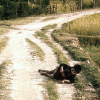Today in Military History:

The Palaus, part of the Caroline Islands, were among the mandated islands taken from Germany and given to Japan as one of the terms of the Treaty of Versailles at the close of World War I. The U.S. military lacked familiarity with the islands, and Adm. William Halsey argued against Operation Stalemate, which included the Army invasion of Morotai in the Dutch East Indies, believing that MacArthur would meet minimal resistance in the Philippines, therefore making this operation unnecessary, especially given the risks involved.
Peleliu was subject to pre-invasion bombardment, but it proved of little consequence. The Japanese defenders of the island were buried too deep in the jungle, and the target intelligence given the Americans was faulty. Upon landing, the Marines met little immediate resistance—but that was a ploy. Shortly thereafter, Japanese machine guns opened fire, knocking out more than two dozen landing craft. Japanese tanks and troops followed, as the startled 1st and 5th Marine regiments fought for their lives. Jungle caves disgorged even more Japanese soldiers. Within one week of the invasion, the Marines lost 4,000 men. By the time it was all over, that number would surpass 9,000. The Japanese lost more than 13,000 men. Flamethrowers and bombs finally subdued the island for the Americans—but it all proved pointless. MacArthur invaded the Philippines without need of Army or Marine protection from either Peleliu or Morotai.
Whether or not the islands should have been taken is a matter that is still hotly contested by veterans and historians alike. Whatever the arguments, it must be remembered that:
General Douglas MacArthur's flank was secured for his return to the Philippines and the danger posed by airstrikes or troop reinforcements from the Palau Islands were removed.
Several thousand of the best Japanese troops had been eliminated and the remaining troops in the Western Carolines could be effectively contained with air and naval power from the bases on Peleliu and Angaur.
This operation served as an early indicator to the change in Japanese tactics that would be seen in other operations to come (such as Iwo Jima and Okinawa) and of what to expect in the planned invasion of the Japanese homeland (Operation Downfall).
General Clifton B Cates, who after World War Two became Commandant of the US Marine Corps, suggested that Peleliu was one of the most vicious, stubbornly contested and least understood battles of the war - a significant appraisal coming from a veteran (wounded six times) of the battles for Belleau Wood and Soissons during the First World War and of Guadalcanal and Iwo Jima in the Second.
Major General Roy Geiger called Peleliu 'the toughest fight of the war". Harry Gailey exclaims, "in terms of heroism, every man who fought at Peleliu deserved the highest awards his country can bestow." Eugene Sledge wrote that it was a "nether world of horror from which escape seemed less and less likely as casualties mounted and the fighting dragged on and on. Time had no meaning; life had no meaning. The fierce struggle made savages of us all." Leon Uris states "the Marine battle for Peleliu was one of the most savage of the Second World War." Tom Bartlett (Managing Editor, Leatherneck) said "Peleliu . . . shows perhaps more than any other World War II invasion, the true mettle of the Marines and their devotion to each other, their units, and the Corps."
Operation Stalemate, the battle for Peleliu, one of the US Marine Corps' hardest battles of the Pacific War
www.historyofwar.org












